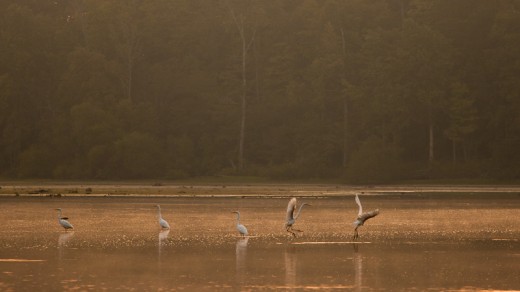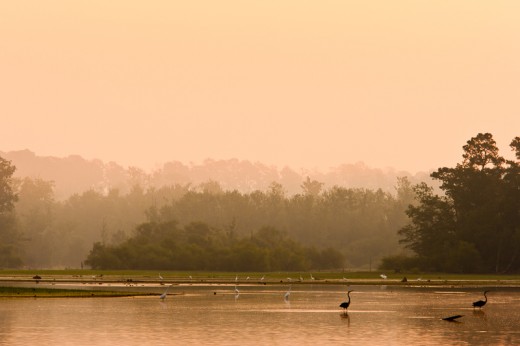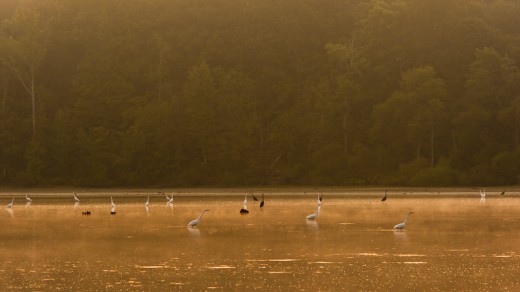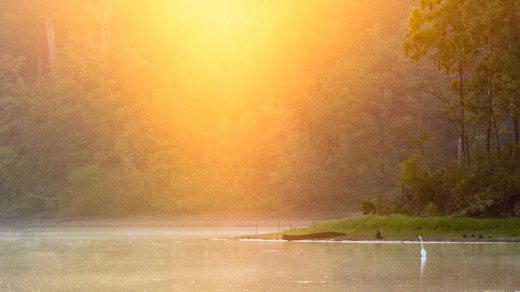Egrets! An Essay on How to Be Prepared and Unprepared for a Shoot

Those that know me know that above all, I am a portrait shooter–I like photographing people. However, as I’ve mentioned before in this blog, when I’m not photographing people, I push myself to photograph other things–landscapes, wildlife, skateboarding, whatever. Whether the photographic results are good or bad, they always teach me something, usually useful, about myself, my camera, my gear, or about the world around me.
This morning, I got up before dawn, which is something I usually only do because I have to work. I brewed some fresh coffee, and started packing my camera bag. I made sure I had my 16-35, my 70-200 f/4 with tripod collar, my polarizer. I double checked for the things I use less often–soft and hard graduated neutral density filters, the filter holder, a step-up ring for the 70-200 so I could use the filters, my teleconverter.

My gear packed, I drove out to Mapleview, a dairy farm in Chatham county that is a favorite of mine for ice cream, relaxing, getting away from town for a minute, whatever. It is one of the places I go to relax, usually in the late afternoon and evening, when the sun is setting over the grain elevator and pastures. I’ve only photographed around Mapleview one other time at dawn, way back when I was still shooting Nikon, and really enjoyed the experience. So I headed back, knowing the sunlight would be at my back and hoping to get some nice, bucolic late summer photos.

I arrived at my parking spot, got out of the car and popped the trunk, looked out over the fields still dark in the predawn, a low fog hanging around the trees. It would be a lovely morning to photograph. And then I opened the trunk, only to find……. I’d left my tripod at home! A twenty minute drive wasted, and precious little time to go till dawn. I could stay, shoot high ISOs or wide apertures and hope for some okay images, or I could rush home, grab the tripod, and try to rescue the morning by going somewhere closer to home and beat the sun. I chose the latter. So, lesson #1 in how to be prepared: pack all your gear the night before when you are sharp and not sleepy or rushing–you are much more likely to forget that one essential piece of gear that will keep you from getting optimal images.

From the images in this blog post, you may have realized that my fallback location was Jordan Lake, a finger of which is about fifteen minutes from my door. It is an area I have scouted extensively, and I know, generally, what it will look like at a given time on a given day. Lesson #2 for being prepared: the more you know about a given location, the more quickly you can get to optimal photographic places and get set up. I was able to get the tripod, get to Jordan Lake, hike through the woods to the shore, and get everything set up before the sun rose.
I was fortunate this morning to find what I did: a large congregation of egrets and herons, brought together by the low lake levels, which create mudflats and large expanses of shallow water, perfect hunting grounds for these shorebirds. Most people associate ultra wide angle lenses with landscape photography, but every one of these photos was taken with the 70-200 AND the 1.4x teleconverter, for a maximum focal length of 280mm. Of course I’d like longer, but it gets the job done. Lesson #3: Just because you plan to use your UWA lens for your landscape photos, bring along a telephoto, just in case–you never know what you might be able to do with it.

The final lesson is to be prepared for the unexpected. I had finished shooting this side of the lake and headed over to the other side, where the sun was at my back. I was setting up to shoot landscape photo featuring the full moon over the lake, when a decidedly non-heron like bird flew by. I still had my 70-200 + teleconverter on the camera, but it was otherwise set up completely wrong for shooting a bird-in-flight. I fumbled with the settings, managed to get a few set right, and captured this:

No, it’s not a great bald eagle photo and no, it won’t win any awards, but that’s kind of my point. If I had been paying closer attention, and had set up my camera for this sort of chance encounter while I was walking, I might have been better prepared and might have taken a better photo–this eagle came from behind me, and was much closer than when I finally captured this frame. At the same time, though, I was semi-prepared in the sense that I had my teleconverter and telephoto with me, and that I know my camera well enough that I was able to make some settings changes quickly enough to get a photo before the eagle soared away.
In the end, it was a lovely morning to be alive, and outside, and watching the world awaken. You should always be prepared to experience that, to enjoy the freshness and hope of dawn or whatever it is you are photographing. You should always be prepared to experience life, and everything else, including photography, should be secondary.

